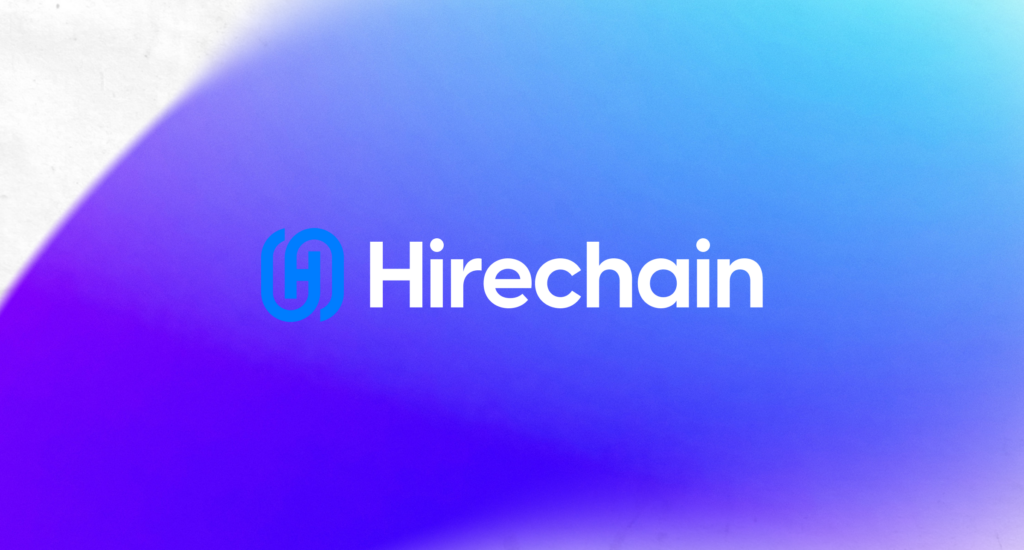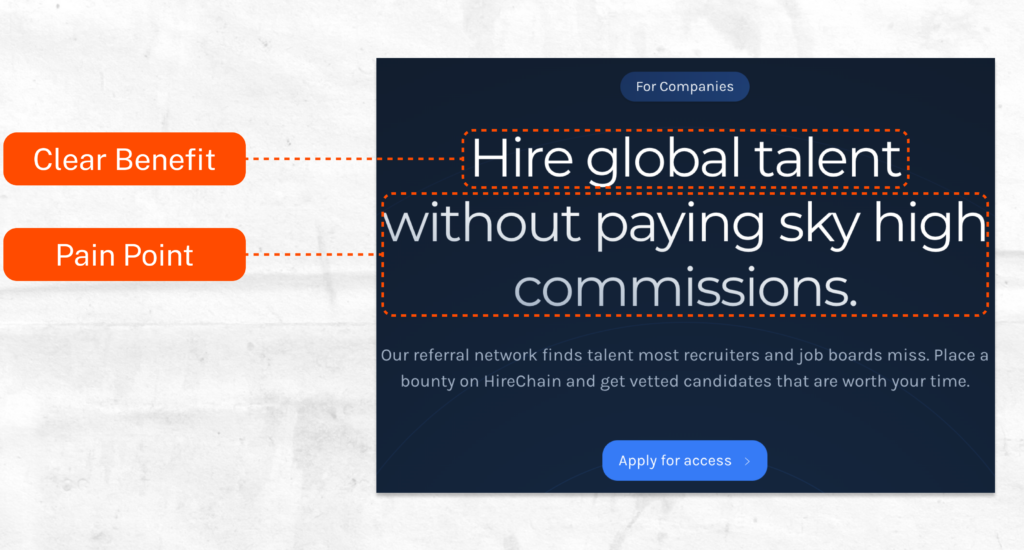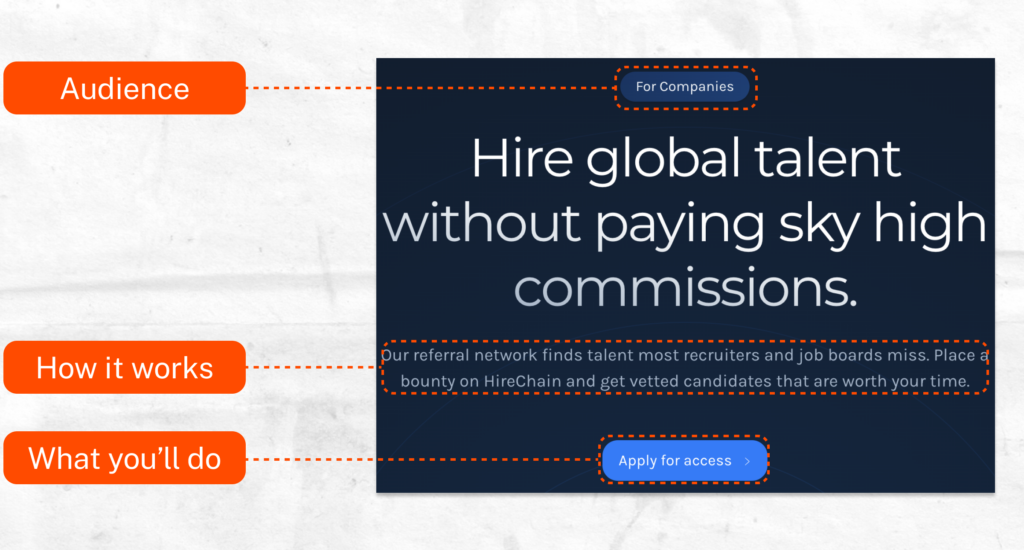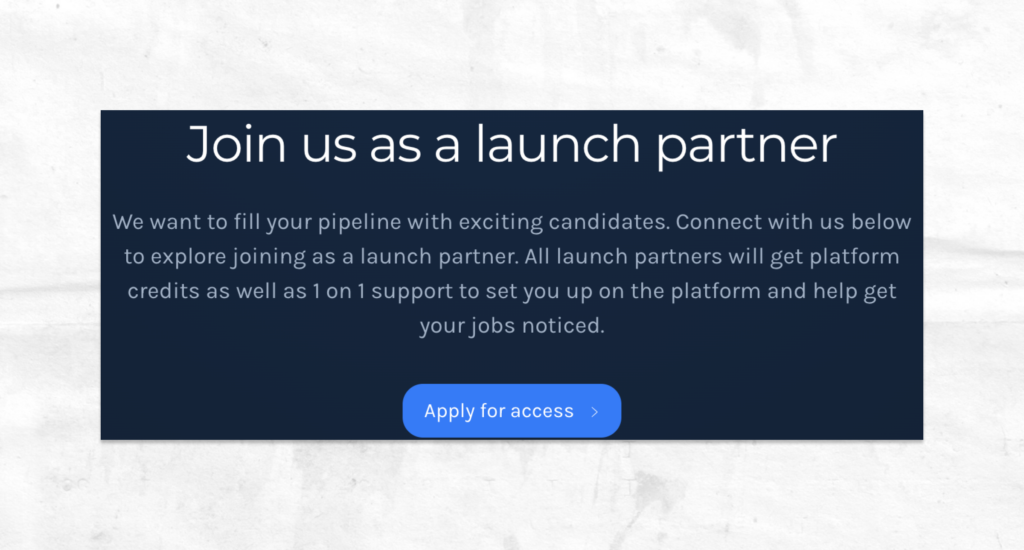
What:
Hirechain is an HR tech startup for web3, backed by crypto data and analysis firm Messari. The company connects talent with companies in the cryptocurrency industry.
There are many recruiting firms, but few have the industry expertise to find qualified candidates in the budding web3 space. Referrals remain the best source of talent. That’s why Hirechain built a platform that incentivizes referrals with bounties for referrers to web3 roles (even if the person doesn’t get hired).
Why:
Startups need to clarify what they do, the problems they solve and who it’s for. I worked with the Hirechain team to define core messages and create a website that explains the product.
How:
It’s easy to see a finished outcome. But good outcomes are usually a result of a good process. Here’s how the collaboration with Hirechain went:
1. Workshop/Interview
Many marketing deliverables disappoint. Projects get stuck in never-ending revision cycles, delays accumulate, resentment grows on both sides.
It’s rarely because of a lack of skill or bad intentions. Usually, it’s caused by differing expectations. Especially in creative fields, the creative needs to get the business. They need to understand:
- What the business does (easier said than done, especially in tech!)
- Who it’s for: What they struggle with, what their goals are and how they frame those things
- What uniquely positions the business to solve those problems (and why other solutions don’t work)
- Why it all matters—what’s the positive impact if this succeeds?
There are more things you might ask about, but these are a few basics. If a service provider knows these things, it sets the collaboration up for success because they don’t have to guess.
This is why I started the collaboration with Jac with a one-hour interview. In it, I asked questions like the above. He helped me understand the market, the business model and the target audience’s frustrations and needs.
This gave me the information I needed to complete the next step:
2. Messaging Principles Document
When it comes to messaging strategy, most companies are on an extreme of a spectrum:
Flying blind
Many companies never document which messages their marketing needs to transmit. This gives autonomy to channel experts, but:
- Makes onboarding hard: Without documentation, there are no objective standards.
- Prevents brand building: Your brand are the associations your target market builds with your company over time. If those aren’t consistent, you won’t build a brand.
- Diminishes conversion: If the person running ads and the person creating the landing page those ads send traffic to don’t build on the same foundation, progression throughout the funnel gets confusing.
Waxing poetically
These brands have a brand book, branding guidelines, a style guide and weekly review meetings. They document, but are abstract and poetic.
Calling yourself an “explorer brand that’s always challenging the status quo” sounds nice. But it’s vague. It doesn’t help write or design because it lacks specific instructions.
It’s hard to say if a given piece of copy successfully transmits an “explorer archetype”. But there’s a clear yes/no if you ask whether it communicates that you solve the problem of recruiters charging extortionate fees for web3 candidates.
Striking the right balance
You need documentation that helps new team members create effective marketing assets quickly. It needs to instruct without constraining and leave wiggle room without leaving everything open.
A good messaging strategy is like jazz: The basic elements are set, but the specific implementation leaves endless room for creativity.
That’s why, based on my interview with Jac, I created a messaging principles document for Hirechain. It has 3 parts:
What the document is for: The problem with much documentation is that it gets ignored. By explaining why it matters and how it helps the reader (a team member) do their job faster and better, we make sure it’s usable.
Messaging principles: These are the jazz chords to Hirechain’s marketing.
- Who Hirechain is for
- Who Hirechain is not for
- What do they struggle with? (both emotionally and practically)
- Solutions: How Hirechain solves those problems
- Uniqueness: Why Hirechain is uniquely positioned
How to use the document: A short section outlines how to create marketing assets based on the messaging principles. It explains that the recombination of different elements will consistently lead to on-brand marketing assets.
After we agreed the messaging principles were fitting for Hirechain, we had a foundation. Getting to consensus here shortens feedback cycles and reduces revisions because it’s the foundation of the copy written after this step. After we agreed, it was time to write copy.
Landing Page Copy
As a platform for both referrers and companies, Hirechain is in a unique position of having multiple target audiences. This can make it challenging to write copy: Good copy is specific to the target audience it addresses. If the same copy tries to persuade multiple audiences, neither will be convinced. Try to appeal to everyone and you’ll appeal to no one. Your messaging will be watered down, general and boring.
This is why we decided to create two distinct landing pages: One for companies, one for referrers. Let’s look at the copy for the hiring page:
Headline section
Nothing is more important than the first few lines someone reads. This is where your reader decides:
- Is this for me?
- Do I want this?

The copy is simple:
- Clear benefit: We state the outcome the HR professional will get (hiring global talent).
- Pain point: In saturated markets, everyone promises the same outcome. That’s why you need to differentiate to get attention. By stating that we don’t have the downside of high commissions, we get the market’s attention.
Let’s look at the details:

- Audience: Calling out the audience is a simple step many don’t take. By stating who it’s for, your reader knows it’s for them.
- How it works: This is important. If you make a bold promise like finding talent without high commissions, a potential client will ask how you accomplish that—especially in a low-trust market like recruiting.
By revealing the mechanism (a referral network), we create curiosity and show that Hirechain is not just a recruiting agency. We also call out alternatives (recruiters and job boards) which many HR departments have tried and failed with.
Finally, we make a specific promise: Vetted candidates that are worth your time. The high salaries of product and engineering positions attract tons of applicants, many of which are just “giving it a shot”. HR spends hours sifting through these candidates without making progress on their hires. That’s why we end on that specific benefit. - Apply for access: CTAs are a detail, but make a difference. Hirechain is in beta. That means a “join” button would cause frustration (because they can’t join). A good CTA is descriptive and tells the user what they’ll actually do.

- Free: This one’s easy. If you offer something for free, say it!
- Promise: Especially in B2B, people know there’s no free lunch. By stating Hirechain’s business model, readers don’t worry about hidden fees. This complements the free in the headline above.

The rest of the copy is straight-forward. It explains the product features. One thing is worth highlighting: Showing how something works is often more persuasive than telling them. So while the copy is descriptive, the visuals do much of the heavy lifting here.

The copy here explains the beta access in more detail. But there’s something more interesting here: This CTA is positioned at the bottom of the page. Why? The top section of a website gets the most attention. But the second most-viewed part is the very bottom. That’s why high-converting landing pages often have CTAs visible when you scroll all the way down.
The page for referrers is built much the same way—except with copy specific to that target audience. While this ends the copy analysis part, I want to highlight another reason that made this collaboration fruitful:
The Hidden Power of Good Work Relationships
Both Jac and I enjoyed the collaboration because it was built on mutual respect. Jac didn’t have a narrow vision he wanted me to execute, I didn’t have abstract creative ideas to shoehorn into the landing page.
Perhaps the most important part, facilitated by our initial interview, was that we were on the same team-we both wanted Hirechain to have effective communication to its potential clients and referrers. Individual skills are important. But, as Kevin Kelly says: Being enthusiastic is worth 25 IQ points.
I thank Jac and the Hirechain team for an awesome collaboration.
Check out Hirechain’s website and follow them on Twitter.